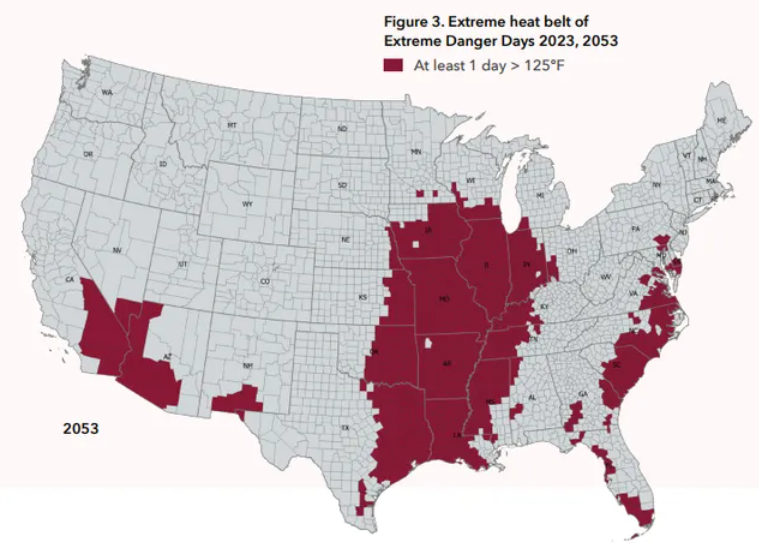Eastern Kansas will see dangerously high temperatures by 2053, a new climate study predicts
Due to climate change, six of Kansas' biggest cities in 2053 will each swelter through at least one day with a heat index of 125 degrees or more, a new study predicts.
Those cities — Topeka, Lawrence, Overland Park, Shawnee, Lenexa and Kansas City, Kan. — are in an "extreme heat belt" where heat indices are expected to get that high, says the report put out Aug. 15 by the Brooklyn-based First Street Foundation.
“We need to be prepared for the inevitable, that a quarter of the country will soon fall inside the Extreme Heat Belt with temperatures exceeding 125°F and the results will be dire," said the foundation's founder and CEO, Matthew Eby, in a news release.
Has Topeka's heat index ever hit 125?

The heat index measures how hot it feels when relative humidity is factored in with the actual air temperature.
No record could be found of Topeka's heat index having ever reached 125 degrees or more.
The National Weather Service's Topeka office doesn't maintain official records of heat index extremes, but that office began keeping unofficial records of heat index readings in 1978, Capital-Journal archives show.
A Topeka heat index of 121 degrees, recorded in 2017, was the highest known to meteorologists this past week at the weather service's Topeka office.
For decades before that was recorded, Topeka's unofficial heat index record was thought to have been 119, recorded in 1986.
The heat index hadn't yet been developed when Topeka saw its record high temperature of 114 degrees, set on July 24, 1936.
What does the First Street Foundation climate study say?
First Street Foundation, a nonprofit that studies climate risk, on Monday made public a peer-reviewed report it had created calculating the heat risk facing each property in the contiguous United States over 30 years, the length of a typical home mortgage.
The report comes out just as the nation is experiencing a succession of heat waves and broken records, according to USA Today.
July was the third-warmest on record in the U.S., and the 76.4-degree average temperature was nearly 3 degrees above normal, the National Oceanographic and Atmospheric Administration said.
Monday's report is the sixth national risk assessment put out by First Street Foundation, it said in an accompanying news release.
The foundation and its partners used federal weather records, property records, satellite information, intermediate global climate projections and other data to create their model. It also took into account tree cover, paved surfaces and proximity to water.
The study concluded that as climate change worsens, millions of people will endure extreme temperatures more frequently and for longer periods of time.
Monday's news release said the study concluded that:
50 U.S. counties, which are home to 8.1 million people, are expected to see heat indices of 125 degrees or more in 2023. It described days that see a 125-degree heat index as "Extreme Danger Days."
In comparison, 1,023 counties — which are home to 107.6 million Americans and amount to one-quarter of this nation's land area — are expected to see Extreme Danger Days in 2053.
"This emerging area, concentrated in a geographic region the Foundation calls the 'Extreme Heat Belt,' stretches from the Northern Texas and Louisiana borders to Illinois, Indiana, and even into Wisconsin," it said.

35 Kansas counties are part of the 'Extreme Heat Belt'
None of the 105 counties in Kansas are expected to see an Extreme Danger Day in 2023, according to a graphic that is part of the report.
But the foundation predicts the heat index will reach 125 degrees at least once in 2053 in 35 Kansas counties, all in the eastern third of the state.
Those counties are Shawnee, Douglas, Johnson, Wyandotte, Allen, Anderson, Atchison, Bourbon, Brown, Chase, Chautauqua, Cherokee, Coffey, Cowley, Crawford, Doniphan, Elk, Franklin, Greenwood, Jackson, Jefferson, Labette, Leavenworth, Linn, Lyon, Miami, Montgomery, Nemaha, Neosho, Osage, Pottawatomie, Riley, Wabaunsee, Wilson and Woodson.
Study predicts number of 108-degree heat indices in Topeka will more than double
The study's model also highlights the local impacts of climate change by identifying the seven hottest days expected for any property in 2023, and using that metric to calculate how many of those days would be experienced in 2053.
It offers an online tool called "Heat Factor" to enable the public to look at projections and trends over the next 30 years for specific properties. That can be accessed by going online to RiskFactor.com.
According to figures from that site:
The heat index currently reaches 108 degrees or more on each of Topeka's seven hottest days of the year.
The number of days annually on which Topeka sees a heat index of 108 degrees or more is predicted to rise from seven in 2023 to 17 in 2053.
The likelihood of a heat wave in Topeka, which is defined as three or more straight days with a temperature of 108 or more, is predicted to rise from 47% in 2023 to 81% in 2053. Thirty years ago, the likelihood of a heat wave in Topeka was 22%.
Consequences of higher heat can be severe
The study encourages people to take into account the consequences that significantly higher temperatures would bring.
Since warmer air has a higher capacity to hold water, it says, increased evaporation would bring increased humidity, which would raise heat indices and drastically increase the chances people would suffer from heat-related medical problems.
The increase in potential heat waves and warmer nights is “really concerning,” Gabriel Filippelli, executive director of Indiana University’s Environmental Resilience Institute, told USA Today.
People tend to be able to handle one or two days of hot weather, but when that stretches to three or four days, human body systems start to break down, especially in children, the elderly and those in lower-income communities, Filippelli said,
When heat concentrates in urban areas, temperatures don’t drop at night and people get little, if any, relief, he said.
The study also warns that excessive heat can cause power outages and damage public infrastructure. Energy companies might increasingly need to use brownouts and rolling blackouts, it says.
Use of air conditioning could also rise, potentially increasing the amounts people pay for electrical service, the study says.
Tim Hrenchir can be reached at threnchir@gannett.com or 785-213-5934.
This article originally appeared on Topeka Capital-Journal: Future 'extreme heat belt' will include eastern Kansas, study says

